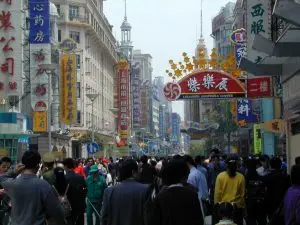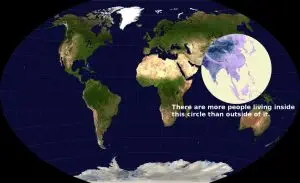More Than Half the World’s Population Lives Inside This Circle

The earth’s population is not spread out equally over its service, as you probably know. The population density of Greenland, for example, is just 0.1/sq. mi—that is, one person living on every ten square miles of rock and ice. But it’s a lot easier to find company in Manila, which is literally one million times as crowded: 107,000 Filipinos per square mile. And there’s no better way to illustrate this differential on a global scale than with a 2013 map called the “Valeriepieris circle.”
Reddit user Valeriepieris’s map.
Where does exactly half of the human race live?
In 2013, a Texas ESL teacher named Ken Myers took a fellowship in bustling Manila. Noticing the big difference between Asian population densities and what he was used to back home, Myers got out a map, opened Wikipedia, and started doing some rough calculations: What was the smallest circle on the earth’s surface that held more than half the world’s population?
The majority of us live in a surprisingly small radius.
What makes this question interesting is that four of the six most populous nations on the planet (China, India, Indonesia, and Pakistan) and eight of the top fifteen are located in Central and East Asia. Myers was amazed to find that a circle roughly 2,500 miles in diameter, when placed over the right part of Asia, could hold more than half the world’s population. He posted his discovery on Reddit, which dubbed it the “Valeriepieris circle” in honor of Myers’s username. The map quickly spread to Slate, The Washington Post, and the four corners of the Internet as an eye-opening demonstration of just where the bulk of humanity lives right now.
A tiny Burmese village is the center of the center of the world.
In 2016, a Singapore economics professor named Danny Quah double-checked Myers’s math with more detailed population data and an exhaustive computer algorithm. His version of the circle is slightly smaller, and doesn’t even include most of Japan. He proved that, as of 2015, fully half the people on earth live within a 2,050-mile radius of the Burmese city of Mong Khet.
Find your buddy!
It’s remarkable that the Valeriepieris circle is this heavily populated, considering that a third of it is ocean. It also contains vast, lonely tracts of Siberia and the world’s most sparsely populated nation, Mongolia. But its small size simply illustrates the fact that six out of ten people on the planet live in Asia, four times as many as on any other continent. I think every human being who lives outside the Valerieperis circle should choose a random human on the inside, and make friends. There’s exactly one pen pal in there for every one of us out here.
Explore the world’s oddities every week with Ken Jennings, and check out his book Maphead for more geography trivia.

Leave a Reply